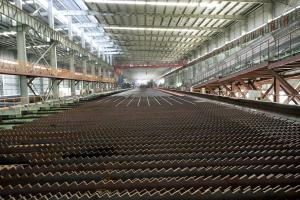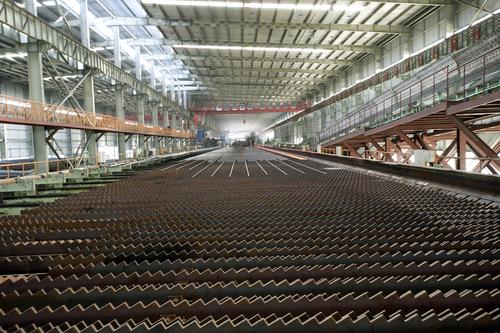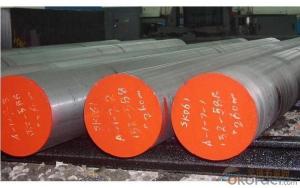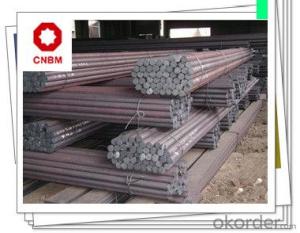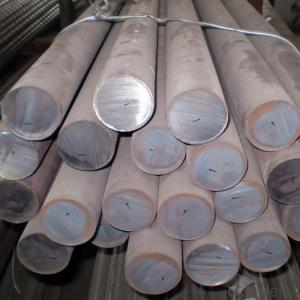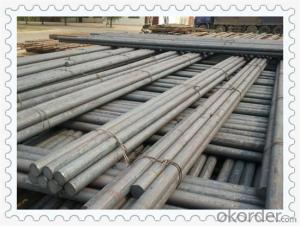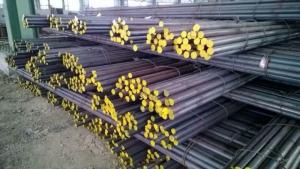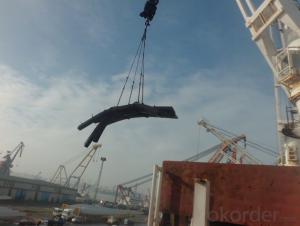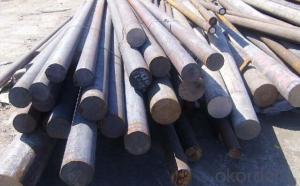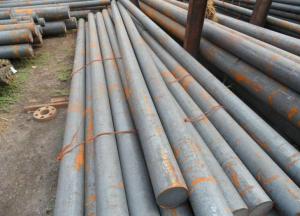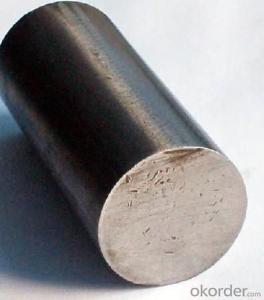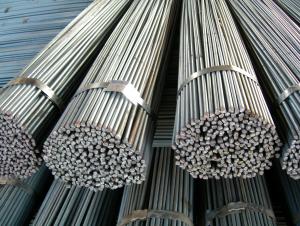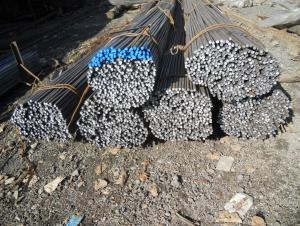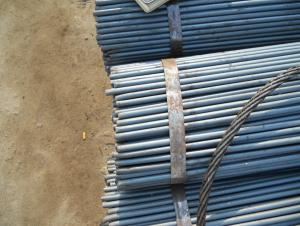Hot Rolled Steel Carbon Round Bar
- Loading Port:
- China Main Port
- Payment Terms:
- TT or LC
- Min Order Qty:
- -
- Supply Capability:
- -
OKorder Service Pledge
OKorder Financial Service
You Might Also Like
Product Description:
OKorder is offering Round Bar at great prices with worldwide shipping. Our supplier is a world-class manufacturer of steel, with our products utilized the world over. OKorder annually supplies products to European, North American and Asian markets. We provide quotations within 24 hours of receiving an inquiry and guarantee competitive prices.
Product Applications:
1. Hot rolled round bar of 6-25mm, or small round is mostly used for straight bundles supply, and used for steel, bolts and various mechanical parts. While the bigger round bar, or more than 25mm hot rolled bar, is mainly for the manufacture of mechanical parts or for seamless steel billet.
2. Besides, we can supply some especial material steel round bar that can be used for main shaft of steamer, hummer shank, with big section and supper force.
Product Advantages:
OKorder's Round Bar are durable, strong, and resist corrosion.
Main Product Features:
· Premium quality
· Prompt delivery & seaworthy packing (30 days after receiving deposit)
· Corrosion resistance
· Can be recycled and reused
· Mill test certification
· Professional Service
· Competitive pricing
Product Specifications:
1. Grade: Q195, Q235, Q345
2. Diameter: 6mm-150mm
3. Length: 6m, 9m, 12m or as customer’s request
4. Tolerance: Within ±5% for weight; ±2mm for diameter
5. Note: The price can be better is the quantity is good
6. Chemical composition
Alloy No | Element (%) | ||||
C | Mn | S | P | Si | |
Q195 | 0.06-0.12 | 0.25 | ≤0.05 | ≤0.045 | ≤0.3 |
Q235 | 0.12—0.20 | 0.3—0.7 | ≤0.045 | ≤0.045 | ≤0.3 |
Q345 | ≤0.2 | 1.00-1.60 | ≤0.045 | ≤0.045 | ≤0.55 |
Packaging & Delivery of Round Bar
Packaging Detail: All goods are packed in bundle with steel strips and shipped by break bulk vessel or container (depend on target market and different ports)
Delivery Detail: 45 days
Trade terms: FOB, CFR, CIF
MOQ: 25 tons per specification; we can negotiate the quantity if the specification is normal or we have stock of one specification.
Weight: Theprice invoicing on theoretical weight basis or actual weight basis depends on customer’s request.
Shipment: The shipment of bulk break or container is depends on customer’s request and the situation of the port of destination.
Documents given: Full set of original clean on board bill of lading; Original signed commercial invoice; Original packing list; Policy of insurance; Certificate of origin and what the target market needs.
FAQ:
Q1: Why buy Materials & Equipment from OKorder.com?
A1: All products offered byOKorder.com are carefully selected from China's most reliable manufacturing enterprises. Through its ISO certifications, OKorder.com adheres to the highest standards and a commitment to supply chain safety and customer satisfaction.
Q2: How do we guarantee the quality of our products?
A2: We have established an advanced quality management system which conducts strict quality tests at every step, from raw materials to the final product. At the same time, we provide extensive follow-up service assurances as required.
Q3: How soon can we receive the product after purchase?
A3: Within three days of placing an order, we will begin production. The specific shipping date is dependent upon international and government factors, but is typically 7 to 10 workdays.
Q4: What makes stainless steel stainless?
A4: Stainless steel must contain at least 10.5 % chromium. It is this element that reacts with the oxygen in the air to form a complex chrome-oxide surface layer that is invisible but strong enough to prevent further oxygen from "staining" (rusting) the surface. Higher levels of chromium and the addition of other alloying elements such as nickel and molybdenum enhance this surface layer and improve the corrosion resistance of the stainless material.
Images:
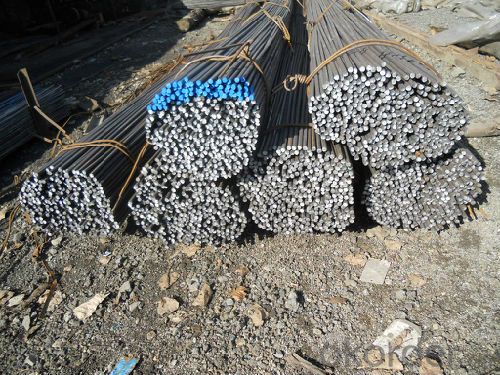
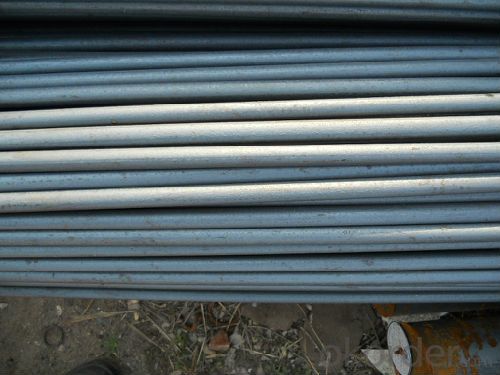
- Q: What are the properties of steel round bars?
- Steel round bars have several properties that make them a popular choice in various industries. Firstly, steel round bars are known for their strength and durability. Steel is one of the strongest materials available, and this strength is retained in the round bar form. This makes steel round bars ideal for applications where high strength and toughness are required, such as in construction, manufacturing, and engineering. Secondly, steel round bars have excellent machinability. They can be easily cut, drilled, and shaped, making them versatile for use in different projects. This property allows for easy fabrication and customization of the round bars to meet specific requirements. Furthermore, steel round bars have good corrosion resistance. They are often made from stainless steel or alloyed steel, which increases their resistance to rust and other forms of corrosion. This makes them suitable for use in outdoor and harsh environments, where exposure to moisture and chemicals can cause damage to other materials. Another important property of steel round bars is their high thermal and electrical conductivity. This makes them suitable for applications where heat or electricity needs to be conducted efficiently, such as in electrical systems or heat exchangers. Additionally, steel round bars have a smooth and polished surface finish. This not only enhances their aesthetics but also improves their resistance to wear and tear. The smooth surface reduces friction and allows for easy movement or rotation, making steel round bars suitable for use in mechanical components and machinery. Lastly, steel round bars are available in a wide range of sizes, grades, and finishes. This allows for flexibility in application and ensures that the right round bar can be selected based on specific requirements. Overall, the properties of steel round bars, including their strength, machinability, corrosion resistance, thermal and electrical conductivity, surface finish, and availability in various sizes and grades, make them a versatile and reliable choice for many industrial applications.
- Q: How are steel round bars used in the construction of high-rise buildings?
- Steel round bars are commonly used in the construction of high-rise buildings due to their strength, durability, and versatility. These bars are typically made of carbon steel, which has excellent mechanical properties and can withstand high loads and pressures. In the construction of high-rise buildings, steel round bars are primarily used in reinforced concrete structures. They are commonly used as reinforcement in concrete beams, columns, and slabs. The bars are embedded in the concrete to provide additional strength and stiffness to the overall structure. One of the main advantages of using steel round bars is their ability to resist tension forces. Concrete is strong in compression but weak in tension, so the steel bars act as tension reinforcement, preventing the concrete from cracking or failing under tension loads. This helps to enhance the structural integrity and overall safety of the building. Additionally, steel round bars can be easily bent, shaped, and welded, allowing for flexible design and construction possibilities. They can be customized to specific lengths and diameters to suit the requirements of the building project. This versatility makes them ideal for constructing various structural elements, such as beams and columns, which need to be precisely engineered to support the weight and stresses of a high-rise building. Moreover, steel round bars have excellent resistance to corrosion, which is crucial in the construction of high-rise buildings that are exposed to various environmental elements. The corrosion-resistant properties of steel ensure the long-term durability and lifespan of the structure. Overall, steel round bars play a vital role in the construction of high-rise buildings by providing strength, durability, and flexibility to the reinforced concrete structures. They enhance the overall structural integrity, safety, and longevity of the building, making them an essential component in modern construction practices.
- Q: Are steel round bars suitable for bearing applications?
- Yes, steel round bars are suitable for bearing applications. They offer high strength, durability, and excellent load-bearing capabilities, making them commonly used in various industries such as automotive, construction, and machinery.
- Q: What are the different types of steel round bars used in the automotive chassis components?
- There is a wide range of steel round bars commonly employed in automotive chassis components. These bars are selected based on their unique properties and performance criteria for different parts of the chassis. 1. Mild Steel Round Bars: Automotive chassis components often utilize mild steel round bars due to their well-balanced combination of strength, durability, and cost-effectiveness. These bars find application in various chassis parts such as brackets, supports, and reinforcements. 2. High-Strength Low-Alloy (HSLA) Steel Round Bars: HSLA steel round bars are crafted by combining low carbon content with small quantities of alloying elements like manganese, phosphorus, and chromium. This steel variant offers superior strength and enhanced formability compared to mild steel. Chassis components that demand critical performance, such as control arms, suspension components, and steering linkages, frequently incorporate HSLA steel round bars. 3. Boron Steel Round Bars: Boron steel round bars are renowned for their exceptional strength and resistance to deformation. These bars are alloyed with boron, which imparts high hardenability and toughness to the steel. Safety-critical chassis components like reinforced door beams and crash structures primarily employ boron steel round bars. 4. Stainless Steel Round Bars: Stainless steel round bars exhibit corrosion resistance alongside excellent strength and durability. While they are not as commonly employed in automotive chassis components, stainless steel round bars may be utilized in specialized parts that necessitate resistance to rust and corrosion, such as exhaust system components or parts exposed to harsh environmental conditions. 5. Alloy Steel Round Bars: Alloy steel round bars are produced by incorporating various alloying elements like nickel, chromium, and molybdenum to enhance specific properties such as strength, hardness, and wear resistance. These bars frequently find application in high-performance chassis components like drive shafts, axles, and gears. To summarize, the types of steel round bars utilized in automotive chassis components encompass mild steel, high-strength low-alloy steel, boron steel, stainless steel, and alloy steel. The selection of the appropriate type depends on the specific requirements of each component, including strength, durability, formability, and corrosion resistance.
- Q: How do you calculate the moment of inertia of a steel round bar?
- In order to determine the moment of inertia for a steel round bar, one must possess knowledge of the bar's dimensions and properties. The moment of inertia serves as a gauge for an object's resistance to rotational changes. The formula utilized to compute the moment of inertia for a solid cylindrical item, such as a round bar, is as follows: I = (π/4) * D^4, where I signifies the moment of inertia and D symbolizes the bar's diameter. Initially, ascertain the diameter of the steel round bar by means of a caliper or ruler. It is essential to measure the diameter at its broadest point, typically found at the center. Subsequently, input the measured diameter into the formula and calculate the moment of inertia. It is crucial to use the correct units for diameter, such as inches or millimeters, to maintain consistency with the formula. For instance, let's assume the diameter of the steel round bar measures 2 inches. By substituting this value into the formula: I = (π/4) * (2 inches)^4 = (π/4) * 16 inches^4 = 4π inches^4. Therefore, the moment of inertia for the steel round bar with a diameter of 2 inches equals 4π inches^4. It is imperative to recognize that this formula assumes a solid cylindrical shape devoid of any alterations in diameter or hollow sections. If the round bar presents variations in diameter or is hollow, the moment of inertia calculation becomes more intricate and necessitates additional considerations.
- Q: What are the different types of steel round bar surface treatments for improved hardness?
- There are several different types of steel round bar surface treatments that can be used to improve hardness. These treatments are designed to enhance the strength and durability of the steel, making it more resistant to wear and tear. Some of the common surface treatments for improved hardness include: 1. Heat Treatment: This is a widely used method where the steel round bar is heated to a specific temperature and then cooled rapidly to alter its microstructure. This process can increase the hardness of the steel, making it suitable for applications that require high strength and toughness. 2. Nitriding: Nitriding involves exposing the steel round bar to a nitrogen-rich environment at high temperatures. This treatment forms a hard layer of nitrides on the surface of the steel, enhancing its hardness, wear resistance, and fatigue life. 3. Carbonitriding: Similar to nitriding, carbonitriding involves introducing both carbon and nitrogen into the steel round bar's surface. This treatment creates a hard and wear-resistant layer while maintaining a tough core. Carbonitriding is commonly used for applications that require a combination of hardness and toughness. 4. Induction Hardening: In this process, the steel round bar is heated through electromagnetic induction and then rapidly cooled. This treatment selectively hardens the surface of the steel, leaving the core relatively unaffected. Induction hardening is effective in improving the hardness and wear resistance of specific areas, such as gears or shafts. 5. Chroming: Chrome plating is a surface treatment method where a layer of chromium is deposited onto the steel round bar's surface. This treatment provides excellent hardness, corrosion resistance, and wear resistance. Chroming is commonly used for applications exposed to harsh environments or for parts that require a smooth and hard surface. 6. Shot Peening: Shot peening involves bombarding the steel round bar's surface with tiny metal or ceramic particles at high speed. This treatment induces compressive stress, which improves the material's hardness, fatigue strength, and resistance to crack initiation and propagation. It is important to note that the choice of surface treatment for improved hardness depends on the specific requirements of the application, the type of steel used, and the desired mechanical properties. Consulting with a materials engineer or specialist is recommended to determine the most suitable treatment for a particular steel round bar.
- Q: What is the difference between a smooth and a precision ground steel round bar?
- A smooth steel round bar is a steel rod with a plain surface and no specific surface treatment or finishing process. It is typically made through hot rolling or cold drawing, resulting in a basic cylindrical shape with a relatively rough surface texture. Smooth steel round bars are commonly used in various applications where a smooth exterior finish is not crucial. On the other hand, a precision ground steel round bar goes through an extra manufacturing process to achieve a more precise and refined surface finish. The process involves removing any imperfections or irregularities from the steel rod's surface, resulting in a highly smooth and polished finish. This ensures that the round bar maintains a consistent diameter along its length and has a superior level of finish and accuracy. Precision ground steel round bars are widely used in applications that require tight tolerances, precision machining, or a smooth and polished surface. Industries such as aerospace, automotive, tooling, and manufacturing often rely on precision ground steel round bars for their high-quality surface finish, dimensional accuracy, and reliable performance. In conclusion, the main distinction between a smooth and a precision ground steel round bar lies in the surface finish and level of precision achieved. While a smooth steel round bar has a basic, rough surface texture and is suitable for general applications, a precision ground steel round bar undergoes additional grinding processes to achieve a highly smooth, polished, and accurate surface finish. This makes it ideal for applications requiring tight tolerances and precision machining.
- Q: Can steel round bars be used in the production of shafts?
- Yes, steel round bars can be used in the production of shafts. Steel round bars are often used as a raw material in the manufacturing process of shafts due to their strength, durability, and versatility. They can be machined or forged into the desired shape and size required for the shaft, and their inherent properties make them suitable for various applications such as automotive, machinery, and construction industries. Steel round bars offer excellent mechanical properties, including high tensile strength, good impact resistance, and resistance to corrosion, making them an ideal choice for shafts that require high load-bearing capacity and reliability. Additionally, steel round bars can be heat-treated to further enhance their strength and hardness, ensuring optimal performance and longevity of the shafts in various operating conditions.
- Q: Can steel round bars be used for making mining equipment?
- Yes, steel round bars can be used for making mining equipment. The strength and durability of steel make it a suitable material for manufacturing various mining equipment such as drill rods, excavator buckets, and support structures due to its high load-bearing capacity and resistance to wear and tear.
- Q: Can steel round bars be coated?
- Yes, steel round bars can be coated. Coating steel round bars with materials like paint, epoxy, or zinc can provide protection against corrosion and enhance their aesthetic appearance.
Send your message to us
Hot Rolled Steel Carbon Round Bar
- Loading Port:
- China Main Port
- Payment Terms:
- TT or LC
- Min Order Qty:
- -
- Supply Capability:
- -
OKorder Service Pledge
OKorder Financial Service
Similar products
Hot products
Hot Searches
Related keywords
